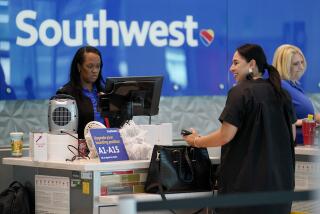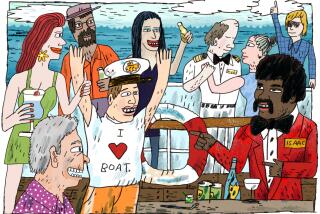Cruise Fares May Be Shrinking as Fleet Grows
- Share via
Good news, vacationers! Cruise stocks tumbling!
Or, to put it more soberly, cruise industry analysts are starting to wonder whether there are enough passengers to fill the 14 new ships due this year. Those Wall Street analysts think fares may be weakening as a result, so the stock prices of Carnival and of Royal Caribbean, the biggest players in the cruise business, have slumped in recent weeks. On Feb. 23, Carnival stock was down 34.8% since Jan. 1, and Royal Caribbean was down 23.6%.
For stockholders this may be cause for alarm. But for consumers chasing bargains, the crucial and encouraging words here are “weakening” and “fares.” While travel agents and other industry veterans have varying views of the short-term supply-demand situation with cruise ships, discount-seeking consumers have several reasons to be encouraged.
The first, several agents and cruise line representatives say, is that prices have been flat or up only slightly from last year’s brochures to this year’s, while the U.S. economy has continued its rapid growth and other prices (like the average U.S. hotel room) have risen. Most major airlines have increased fares with “fuel surcharges” to cover the rising cost of petroleum, but the cruise lines, which buy plenty of fuel too, have held their prices.
At Carnival Cruise Lines, the brochure “super saver” prices on three-day Mexico cruises from Los Angeles on the Holiday inched up from $329 to $339 between last year’s catalog and this year’s, but “super saver” rates for seven-day Mexican cruises on the Elation dipped from $879 to $825. (Still, a Carnival spokesman says prices overall are up slightly from last year.)
The next reason for consumer optimism: the overall supply-and-demand picture. After three decades of growth, the leading cruise lines are in the habit of reinvesting their profits in spectacular new ships. The most notable of these is Royal Caribbean’s Voyager of the Seas, introduced in November as the most capacious ship of its kind. (The ship, scheduled for seven-day cruises in the western Caribbean, holds up to 3,114 passengers and has a rock-climbing wall and a skating rink.) But there are plenty more vessels. The North American market of about 145 ships is expected to grow by 52 ships before the end of 2004, increasing industry capacity by an estimated 65%.
Because fewer than one in 10 Americans has taken a cruise, there’s plenty of room for demand to grow along with the steep increase in supply, the industry’s executives say.
But who knows? The industry’s biggest barometer of demand is “Wave Season,” also called “Wave Period,” the prime selling months of January and February. Wave Season is almost the cruise trade’s equivalent of the retailers’ Christmas shopping season, setting the tone for the rest of the year. This year the season’s sales were especially closely watched by cruise executives and investors, partly because of the increasing ship inventory, partly because of concerns that price-boosting and hype surrounding Y2K cruises might lead to a post-party lull.
In early February, the Cruise Lines Industry Assn., a New York-based trade marketing group, predicted that cruise passenger traffic would increase from 6 million in 1999 to more than 6.5 million in 2000. That would be a record number of cruisers, as the cruise association hastened to emphasize.
That half-million passenger increase works out to a growth rate of about 8%. But with 14 new ships scheduled to join service this year (while two are retired), the total number of beds will increase by about 12%.
A more concrete sign for travelers is the flow of faxes from cruise lines to travel agents in recent weeks. Agents gauge consumer demand not just by their own sales but by the arrival of cruise-line faxes trumpeting discounts on undersold cruises.
Bea Hannan, a Marin County agent who has been selling cruises on and off since 1963, says the discounts she has seen in recent weeks make her think something’s afoot.
One day recently, Princess sent her an offer of $699 per person (double occupancy, air excluded) for two 11-day Panama Canal cruises in March aboard the Sun Princess. The brochure fares for the same cruise were $3,068. “I’ve never seen that before,” Hannan says. (That fare was still available at press time, but because availability is limited, it may have sold out by now.)
At high-end Crystal Cruises, European bookings are running ahead of last year (when hostilities in Kosovo slowed bookings for the eastern Mediterranean), spokeswoman Mimi Weisband says. But she also notes that a May 28 sailing between Athens and Rome has lagged behind the others. In mid-February, in a bid to fill up that 12-day cruise, Crystal dropped 12-day cruise fares of $7,475 to $8,150 to $3,795, a cut of 49% to 53% from brochure rates.
Still, in the larger picture, nobody should count on deep and wide discounting, Weisband says. Some agents agree with that.
“I think the demand now is probably bigger than it’s ever been,” says Shelly Weiner, co-owner of Cruise Stars in Woodland Hills.
“There are a lot of specials coming across because there are more ships competing with each other. You are seeing a lot more 50%-offs,” he says.
Meanwhile, of course, fluctuations in supply and demand don’t mean quite as much in some corners of the market. Crystal Cruises, already selling berths for a 104-day round-the-world cruise beginning in January 2001, has not only sold out its two costliest suites but also has more than a dozen names on a waiting list in case one of them comes open. The fare for passengers in those suites: $166,000 per person.
“So,” Weisband says, “not everybody is looking for the lowest cost per diem.”
*
Christopher Reynolds welcomes comments and suggestions, but cannot respond individually to letters and calls. Write Travel Insider, Los Angeles Times, Times Mirror Square, Los Angeles, CA 90053, or send e-mail to [email protected].
More to Read
Sign up for The Wild
We’ll help you find the best places to hike, bike and run, as well as the perfect silent spots for meditation and yoga.
You may occasionally receive promotional content from the Los Angeles Times.







